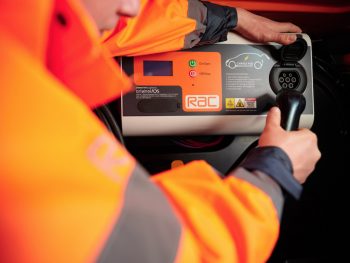RAC rolls out faster emergency EV chargers to patrol vans
The RAC is deploying faster emergency EV charging units in its patrol vans, helping to cut downtime for members.

The RAC EV Boost chargers have now been uprated from 3.5kW to 5kW and can add around 10 miles of range in around 30 minutes or less
Introduced three years after the RAC EV Boost service first went live in a breakdown industry first, the chargers have now been uprated from 3.5kW to 5kW to increase the speed of charge for members who either run out of charge or encounter faulty charge points.
The modern-day equivalent of a fuel can for electric cars, the chargers can add around 10 miles of range in around 30 minutes or less and have been developed by specialist engineering company Original ADS – which signed an exclusivity agreement with the RAC in May 2021.
One in five RAC vans – around 200 vehicles – are expected to be fitted with EV Boost chargers by the end of the year; with as many as 130 of those being the new faster 5kW units.
Work is also underway by the two companies on introducing a 7.5kW charger, which they believe will offer the best possible balance of cost, efficiency and charging time at the roadside.
RAC chief operations director Paul Coulton said: “Having been the first breakdown company to come up with a practical and efficient solution to giving an emergency charge to a flat EV and being the only roadside assistance company in the UK that can use this pioneering British-designed technology, we’re really excited to be speeding up the charger to 5kW so we can save members even more time. And we aren’t stopping there as a 7.5kW version is our next target.”
The chargers avoid the need for breakdown vans to have to carry heavy and bulky batteries that have to be recharged after every use, or having to put the out-of-charge vehicle on to a flatbed recovery truck in order to take it a short distance to a charge point.
And while the RAC has recently added a Renault Zoe EV to its patrol van fleet, it said there still isn’t currently an electric van on the market that can do everything that a diesel-powered one can in terms of towing broken-down vehicles and carrying 500 tools and parts.
“So, even though we’re using a diesel van to recharge an electric car, we’re confident it’s faster, more efficient and better for the planet than having to send a big flatbed recovery vehicle or a van full of batteries,” Coulton continued.
“And, if a member breaks down in an EV for another reason our patrols have more unique equipment in their vans to help. If they can’t fix the fault there and then, they can tow it themselves with our All-Wheels-Up rapid recovery system, meaning there’s no need to wait for a tow truck. It’s like having a flatbed in the back of an RAC van.
“These two breakthrough RAC innovations mean we’re perfectly placed to help any EV driver, whatever problem they might encounter on the road or at home. This should give drivers the confidence to make the switch to electric.”












